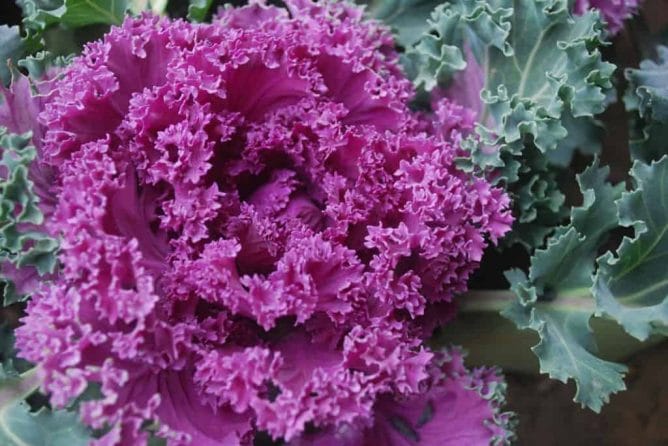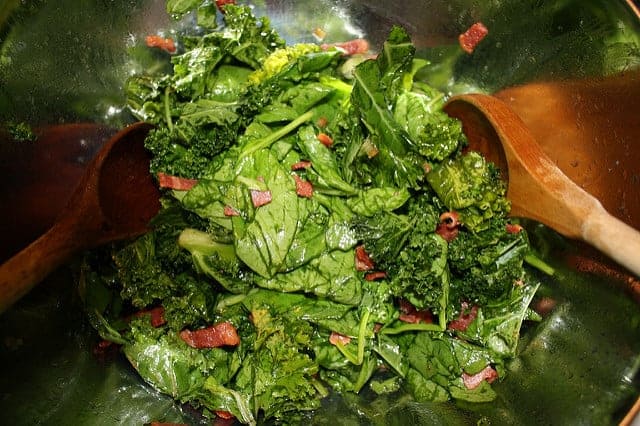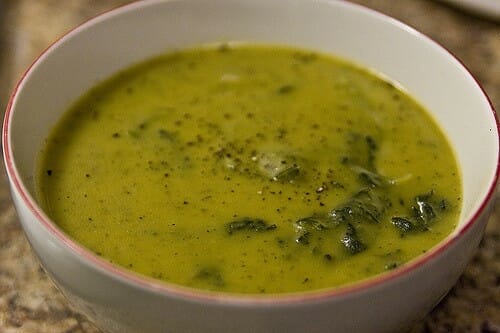Kale is an amazing vegetable in many ways. It is versatile in culinary use and equipped with a lot of useful substances for health. It contains an extraordinary amount of antioxidants (including those belonging to the group of the strongest), which makes it excellent for the immune system. Due to the attractive, crinkled leaves, it is also very decorative. Kale, although it has a great impact on the body and is distinguished by an interesting taste, is not yet very popular. However, it is worth looking for it as often as possible in stores when shopping and including it in various ways in the daily menu. What valuable ingredients can we find in kale? How does it affect our body? How to prepare kale?
Table of contents
What is kale?

Kale is a cabbage vegetable, but in fact it looks more like a lettuce than a cabbage. The taste of kale can be compared to white cabbage, Chinese cabbage or broccoli. The vegetable has long, rather tough, wrinkled leaves that are dark green, green-brown or green-purple in color. Kale leaves are a valued culinary ingredient. They can be added to a variety of dishes, eaten raw or cooked hot.
You can also find powdered kale on sale, which can be added to green smoothies from a blender, yogurt, sauces, soups, etc. Both ground and fresh kale have very high nutritional value.
Kale has been cultivated since ancient times, in the Middle Ages it was one of the most widespread and widely eaten vegetables. Today, this unusual variety of cabbage is grown in many parts of the globe, with the largest crops in northern and central Europe, North America and Asia. Kale is not a demanding plant, it easily adapts to the conditions of its environment. It grows in any fertile soil, the only thing it needs is adequate drainage.
Kale – nutritional values
A key asset of kale is its very high level of saturation with valuable bio-substances. It contains a lot of beta carotene, from which the body produces vitamin A, significant amounts of vitamin K, vitamin C and a wealth of other vitamins and mineral salts. Particularly noteworthy is the multitude of components that act as antioxidants (antioxidants). These include flavonoids, vitamin C and chlorophyll. Kale, like other brassica vegetables, is also rich in sulforaphane, one of the strongest antioxidants.
What valuable things can we find in kale? List of ingredients:
- B vitamins (including folic acid, thiamine, niacin, riboflavin),
- vitamin C,
- vitamin E,
- vitamin K,
- iron,
- potassium,
- calcium,
- magnesium,
- manganese,
- copper,
- zinc,
- selenium,
- sodium,
- phosphorus,
- omega 3 acids (alpha-lipoic acid),
- polyphenols (flavonoids),
- carotenoids (lutein, zeaxanthin),
- chlorophyll,
- sulforaphane,
- indoles,
- dietary fiber,
- protein.
Kale – health properties

Systematic eating of kale is one of the best ways to comprehensively nourish the body and replenish vitamin and mineral deficiencies. The vegetable shows many positive actions. It strengthens the immune system and nervous system, has anti-cancer properties, is a valuable support in the prevention of many diseases (e.g. cardiovascular diseases). It also reduces the risk of lifestyle diseases and helps get rid of many ailments, including those associated with the accumulation of toxins in the body.
There is no doubt that kale is one of the healthiest leafy vegetables in the world. Here are its most important health-promoting properties.
Positive effects of kale on the blood
Frequent consumption of kale is a method to improve blood quality. As one of the few plant products, kale contains vitamin K, which is very important for the proper functioning of our body, in large quantities. Other foods rich in this vitamin include dark green vegetables such as broccoli, spinach, romaine lettuce, Brussels sprouts, arugula, and savoy cabbage. Vitamin K deficiency results in blood clotting disorders, hemorrhages, worse condition of blood vessels (leakage, calcification), increased susceptibility to viral, bacterial and fungal infections.
Kale will supplement deficiencies of vitamin K, and thus improve blood clotting, increase resistance toKale will supplement vitamin K deficiency, and thus improve blood clotting, increase resistance to the action of harmful microorganisms and viruses, reduce inflammation in the body, reduce the tendency to hemorrhage and bruising. Folic acid and chlorophyll present in kale also have a positive effect on the blood.
What is more, kale increases the content of iron, hemoglobin and red blood cells in the blood, thanks to which this vegetableKale reduces the risk of anemia, or helps fight it more effectively if it does occur.
Kale for a healthy cardiovascular system and a strong heart
Kale contains polyphenols in significant amounts, as well as potassium, magnesium and calcium, which help to maintain a healthy cardiovascular system. It seals the blood vessels and increases the elasticity of their walls, helps lower blood pressure, strengthens the heart and stabilizes its work, improves the flow of blood through the tissues. Reduces the risk of heart attacks and cardiovascular diseases. Reduces the level of bad cholesterol, inhibits the process of platelet aggregation and prevents the formation of thrombi and atherosclerosis.
Antioxidant and immune-boosting effects of kale
One of the most important advantages of kale is its unusually high level of antioxidants. This function is fulfilled by the whole range of substances present in this vegetable: chlorophyll, vitamin C, vitamin E, polyphenols, carotenoids, sulforaphane, alpha-lipoic acid (ALA). The impressive antioxidant content makes kale actively:
- inhibits the body’s aging processes,
- strengthens immunity,
- fights harmful free radicals responsible for oxidative stress of cells, protects DNA cells from damage and prevents changes in their structure and mutations,
- reduces the risk of cancer, e.g. breast, lung, colorectal, ovarian, esophageal, bladder, prostate, gallbladder, liver cancer,
- in the early stages of cancer, may inhibit tumor growth and may reduce the risk of metastasis,
- reduces the risk of hypertension, stroke, coronary heart disease, atherosclerosis, asthma, diabetes, joint disease,
- reduces the risk of neurodegenerative diseases such as dementia, Alzheimera disease,
- reduces inflammation in the body,
- stimulates regenerative processes.
Kale is a valuable support in cleansing and deacidification of the body
It is impossible not to mention the cleansing effect of kale. Thanks to the large portion of chlorophyll found in its leaves, as well as sulforaphane and dietary fiber, it actively stimulates the processes of binding and removing all harmful substances from the body, even at the cellular level. By eliminating toxins, heavy metals, deposits and harmful products of metabolism, it contributes to more efficient functioning of our body systems and organs.
An effective way to detox your body: Detoxyn
As kale has an alkalizing effect, it also counteracts acidification and helps to restore the balance between acids and bases in the body and to get rid of unpleasant symptoms of acidification such as digestive complaints, weakness, headaches, tastelessness in the mouth, bad breath, muscle aches, decreased concentration, lack of energy, irritability, decreased immunity, skin and hair problems.
Read also: Deacidification of the body
Kale supports weight loss
Another valuable property of kale is to help you lose weight. The vegetable is rich in dietary fiber, thanks to which it helps to better control appetite and supports digestive processes. Thanks to alpha-lipoic acid, kale improves fat and carbohydrate metabolism, increases the sensitivity of tissues to insulin, normalizes blood sugar levels, and reduces hunger attacks. By improving metabolism, it increases the body’s energy expenditure (calories from food are burned more actively).
Kale – calories
Kale is one of the lowest calorie vegetables. In 100 g of the product you will find only 36 kcal. Two handfuls of kale will provide us with about 15 kcal. Not only because of the low calorie content, but also because of the high fiber content and the power of vitamins and minerals(including electrolytes such as potassium, magnesium and calcium), kale is a product highly recommended in the diet of people striving to reduce body weight.
Check: Ranking of Weight Loss Pills
Why else should you eat kale?
- Thanks to a large dose of calcium, kale has a positive effect on the condition of bones and joints (strengthens them, increases strength, makes them resistant to damage).
- Numerous antioxidants, as well as vitamin A, E and B vitamins present in kale have a positive effect on the condition of skin, hair and nails.
- Thanks to lutein, zeaxanthin and vitamin A, kale is very beneficial for the eyes. It supports good vision and protects the retina, prevents night blindness, protects against eye diseases, including macular degeneration and cataracts.
- With a high dose of vitamin C, kale reduces susceptibility to colds and infections, eases their course and shortens their duration.
- Kale is an excellent source of sulforaphane, thanks to which it fights Helicobacter pylori bacteria. Kale is an excellent source of sulforaphane, which fights the Helicobacter pylori bacteria and thus prevents gastritis, gastric ulcers and duodenal ulcers caused by these bacteria.
- ALA acid and antioxidants contained in kale help detoxify the liver and have a regenerative and protective effect on this organ.
- Kale is an ally for people who work out. By providing protein, complex carbohydrates, vitamins, and minerals, it helps in post-workout recovery, promotes well-being, and has a positive effect on our physical performance and muscle work.
Kale – contraindications. Who should not eat kale?
Kale is a safe product, but there are a few contraindications to its frequent consumption. People with kidney stones and gout should not eat kale, as it contains significant amounts of oxalates.
Due to the content of goitrogens, which inhibit iodine absorption, patients suffering from thyroid diseases should also beware of it. However, there is a way around this – goitrogens oxidize at high temperatures, so simply heat-treating the kale (e.g. by blanching or briefly cooking it) makes it completely safe for people with thyroid ailments.
How to store kale?
Kale is not a very durable product. If we are not going to use kale right after purchase, we need to store it in the right way. It is a very sensitive vegetable, especially reacting badly to humidity and high temperatures. We should remember to:
- keep kale in the refrigerator at all times,
- before storing in the fridge put the kale in a plastic bag with small air holes (then it will stay fresh longer),
- do not wash the kale immediately after bringing it home, do it only before consumption (moisture speeds up the spoilage process).
If you want to store kale for a longer time, you can also freeze it.
Kale recipes. What to do with kale? How to compose dishes with kale?

Although it may seem difficult to make a specific dish out of it, kale is very versatile when it comes to culinary applications. It is a great addition to both cold and hot dishes and is suitable for both small snacks and main courses.
Kale is of course most nutritious when eaten raw (e.g. as an addition to smoothies, salads). If you want to serve kale hot, but want to keep as much of the nutrients as possible, instead of boiling it for a long time, just boil it, blanch it or steam it for a short time.
How to prepare kale raw?
Kale raw can be used in dozens of ways. You can add it to sandwiches, tortilla pancakes, salads, salads, and small snacks with fillings such as rolls, pouches, and tartlets. Kale smoothies are also a very healthy and diet idea.
Smoothies with kale can be made easily by blending its leaves with other vegetables and optionally with fruits, nuts and seeds.
Sample smoothie ingredient combinations:
- kale, kiwi, apple, celery, cucumber,
- Kale, spinach, orange, ginger,
- kale, carrot, celery, parsley, lemon juice,
- kale, banana, tangerines, sunflower seeds,
- kale, celery, pear, parsley.
How to cook kale hot?
An option that will especially appeal to people on a diet concerned with keeping their meals as low-calorie as possible is a filling and nutritious kale cream soup.
You can prepare it by stewing kale and other vegetables of your choice (such as green peas, chickpeas, fresh onions or chives, garlic, parsley, celery, carrots, etc.), then combining the ingredients with bread.), then combining the ingredients with lean broth, blending everything smooth, and finally seasoning.
There are other interesting kale recipes as well. It is actually a very versatile vegetable that goes well with most culinary products. You can braise it, fry it, boil it, bake it, add it to stuffings, soups, stews, pizzas, sauces, and also make vegetable cutlets with it.
One of the quick, easy to prepare and extremely tasty dishes is kale omelet.
Fresh kale leaves (about 5 pieces) wash, cut off the tough stalks and cut into smaller pieces. Cut the red bell pepper into cubes. Fry the kale and peppers in oil or olive oil. Pour 2-3 beaten eggs and spread in the frying pan. Fry over low heat until the eggs are set, moving the pan every now and then. At the end of frying add shredded feta cheese. When the cheese melts, the dish is ready.
Other interesting kale dishes:
- baked kale with macaroni and cheese,
- tart with kale, olives and ham,
- pasta with kale and sun-dried tomatoes from a pan,
- kale pesto,
- chicken breast stuffed with kale,
- one-pot soup with kale, chickpeas, garlic and tomatoes,
- porridge with kale and mushrooms,
- light vegetable soup with kale, carrots, leek, peppers, zucchini and tomato,
- green kale dumplings,
- healthy kale chips,
- kale and cheese dumplings.
Check: Chasteberry and its properties

